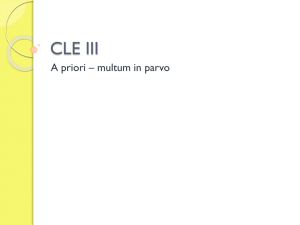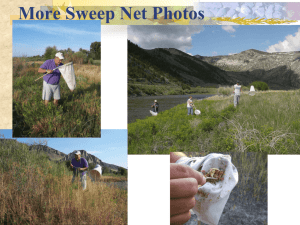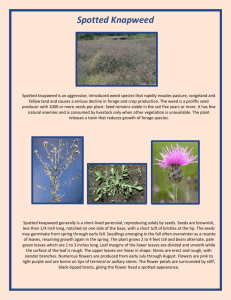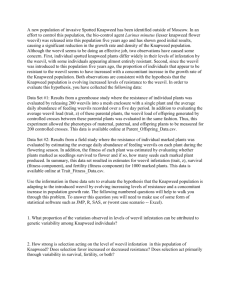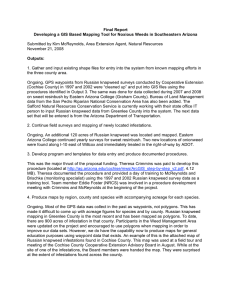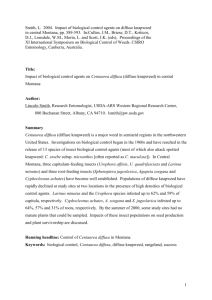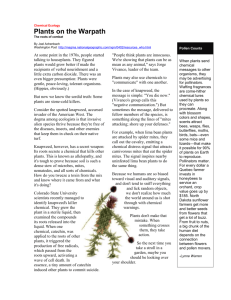Cyphocleonus achates Impact on Spotted Knapweed
advertisement
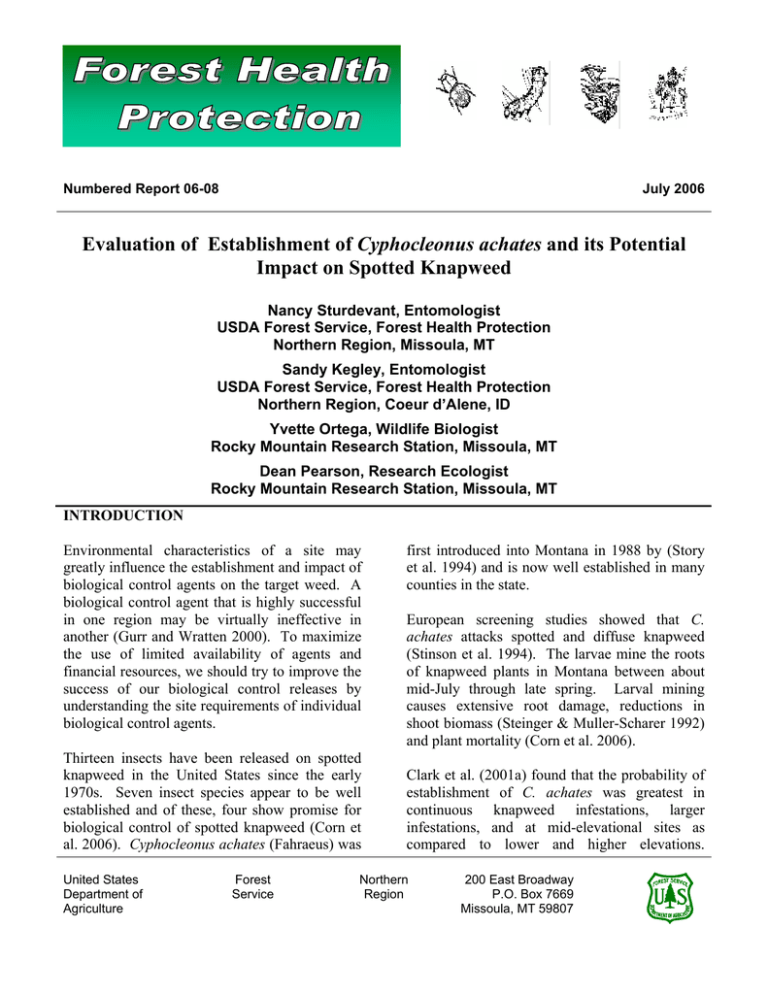
Numbered Report 06-08 July 2006 Evaluation of Establishment of Cyphocleonus achates and its Potential Impact on Spotted Knapweed Nancy Sturdevant, Entomologist USDA Forest Service, Forest Health Protection Northern Region, Missoula, MT Sandy Kegley, Entomologist USDA Forest Service, Forest Health Protection Northern Region, Coeur d’Alene, ID Yvette Ortega, Wildlife Biologist Rocky Mountain Research Station, Missoula, MT Dean Pearson, Research Ecologist Rocky Mountain Research Station, Missoula, MT INTRODUCTION Environmental characteristics of a site may greatly influence the establishment and impact of biological control agents on the target weed. A biological control agent that is highly successful in one region may be virtually ineffective in another (Gurr and Wratten 2000). To maximize the use of limited availability of agents and financial resources, we should try to improve the success of our biological control releases by understanding the site requirements of individual biological control agents. Thirteen insects have been released on spotted knapweed in the United States since the early 1970s. Seven insect species appear to be well established and of these, four show promise for biological control of spotted knapweed (Corn et al. 2006). Cyphocleonus achates (Fahraeus) was United States Department of Agriculture Forest Service first introduced into Montana in 1988 by (Story et al. 1994) and is now well established in many counties in the state. European screening studies showed that C. achates attacks spotted and diffuse knapweed (Stinson et al. 1994). The larvae mine the roots of knapweed plants in Montana between about mid-July through late spring. Larval mining causes extensive root damage, reductions in shoot biomass (Steinger & Muller-Scharer 1992) and plant mortality (Corn et al. 2006). Clark et al. (2001a) found that the probability of establishment of C. achates was greatest in continuous knapweed infestations, larger infestations, and at mid-elevational sites as compared to lower and higher elevations. Northern Region 200 East Broadway P.O. Box 7669 Missoula, MT 59807 larvae in roots of knapweed plants collected at points equally spaced along four transects radiating from the central release point (n=52/site in 1997-98 and n=20/site in 2002-3). Root sample size was reduced because a separate study showed no significant differences in the average number of larvae when sampling 20 versus 52 roots (Sturdevant and Dewey 2002). Counts of adult C. achates from sweep net sampling were used to assess presence of weevils, but otherwise were not considered in analyses since sampling of larvae in roots provides a more consistent measure of abundance (Clark et al. 2001a). Sturdevant and Dewey (2003) reported that size of plants, weather conditions during and following the insect release, number of years since the release and number of insects released can influence the probability of establishment of C. achates. Recent declines of spotted knapweed in western Montana have been coincidental with the release of C. achates and the recent drought. Beginning in 1997, Forest Health Protection in cooperation with other USDA Forest Service and county weed cooperators began to monitor impact of weevils on knapweed at previous release sites. The objectives of this project were to: 1) evaluate the relationship between environmental variables and the establishment of C. achates at release sites to try and identify factors that may determine establishment success, and 2) examine the relationship between C. achates presence and abundance and changes in spotted knapweed over time to assess the short-term efficacy of this agent in suppression of its target weed. Environmental variables describing site-level characteristics were assessed once during the study period. Variables included: elevation, aspect (reclassified as warm [ S, SW, W] versus cold [N, NE, E]), slope, topography (reclassified as valley bottom versus not), disturbance level (reclassified as low [scores 0-1] versus high [scores 2-31), and primary soil type (reclassified as sandy versus not). Categorical variables were reclassified to reduce the number of classes and increase the number of observations per class, thereby facilitating analyses. However, before doing so, preliminary relationships with C. achates prevalence were considered to assure that patterns were not lost as a result of collapsing classes. METHODS 1997/2002 Data The primary dataset analyzed was based on 48 study sites sampled in both 1997-98 and 200203. Records indicated that C. achates had been released at 46 of these sites between 1991 and 1997, with most releases occurring in the 19931996 period. An average of 150 weevils was released per site (range 26-445). Two additional sites with no record of C. achates release were included in analyses since weevils were detected on these sites during initial sampling. According to records, the biological control agent Agapeta zoegana was also released and/or detected at 41 of the study sites within the same timeframe as C. achates. Additional environmental variables described vegetation. In 1997 and 2003, cover of bare ground, shrubs, spotted knapweed, and remaining vegetation were visually estimated from the release point within a 1/300-acre circular plot. In addition, density of knapweed stems was measured in both sampling periods within 16 1-m plots radiating out from the release point in the four cardinal directions. In 2002 & 2003 only, average height of mature knapweed plants, density of mature knapweed plants, and cover of knapweed seedlings were also recorded within 16, 1-m plots. In 1997 and 2002, densities of C. achates and A. zoegana per study site were assessed by counting 2 variables with year effects). Mixed linear models were used to conduct tests, with year treated as a repeated measure. 2002-2004 Data Additional data relating C. achates prevalence to knapweed characteristics, 2002-2004, were obtained from a report to FHP by Sturdevant and Dewey (2003). Study sites (n=15) had been chosen from a set of C. achates release sites (first monitored in 2002) because they had moderate to high numbers of weevils. At each of these sites, relative abundance of adult C. achates was estimated by sweeping a total of 300 meters of knapweed per site. Sweeping began near the release point and continued through the densest portions of knapweed surrounding the release point. Knapweed characteristics including height of mature plants, density of stems, and density of mature plants were measured in 16 1-m plots that radiated out from the release point in the four cardinal directions. All sampling was done approximately during the first 2 weeks in August. Knapweed characteristics measured from 20022004 were analyzed with the same mixed model used in the 1997/2002 analysis, i.e., testing knapweed variables for association with C. achates, for population trends, and for influence of C. achates on population trends. Total number of adult weevils caught in sweep nets was used to represent the prevalence of C. achates per site and year since larval counts were not available. All statistical analyses were conducted with SAS (SAS Institute 1999). We report least squares means from mixed models instead of raw means to adjust for imbalances in sample size and account for influence of covariates. RESULTS Statistical Analyses 1997/2002 Data We used the 1997/2002 dataset to relate the degree of C. achates establishment to environmental site variables. The degree of C. achates establishment per release site was defined and independently analyzed in two ways: 1) presence of C. achates as determined by detection of C. achates larvae or adults in 2002, and 2) density of C. achates larvae in 2002. We used logistic regression to evaluate the presence of weevils as a function of background environmental variables (i.e., excluding knapweed characteristics). Similarly, we evaluated the relationship between density of weevils and background environmental variables using mixed linear models. Densities of C. achates increased substantially at release sites between 1997-98 and 2002-03, from an average of 0.08 ± SE of 0.067 larvae/root to 0.3 ± 0.068 larvae/root (P=0.012). Neither release date, number of C. achates released, nor number of releases were significantly related to densities of C. achates larvae in 2002 (P>0.4). However, densities of C. achates were positively associated with densities of A. zoegana (P=0.01). C. achates was detected at 36 of 48 release sites in 2002. Multivariate analysis of background environmental variables indicated that primary soil type and topography were associated with the presence of C. achates in 2002: weevils tended to occur at sites with sandy soils (P=0.026) located in valley bottoms (P=0.046). Remaining background environmental variables showed no significant relationships with the presence of weevils (P>0.37). Sites with sandy soils tended to have higher densities of C. achates larvae in 2002, but the difference was only marginally significant in a multivariate test In a second analysis, we examined knapweed characteristics measured in 1997 and 2002, testing for: 1) association with C. achates establishment in terms of presence of weevils and density of larvae, respectively, 2) population trends (i.e., differences between years), and 3) influence of C. achates establishment on population trends (i.e., interaction of C. achates 3 49.7 ± 3.94% in 1997 to 41.7 ± 4.09% in 2002 (P=0.02). The decline in knapweed cover over this time period tended to be greater at sites where C. achates was present compared to sites where it was absent, but this difference was not statistically significant (P=0.16; Fig. 1). When soil type and topography (i.e., variables that were significantly associated with the presence of C. achates) were included in statistical models, results were not altered. (P=0.061) and less so in a bivariate test (P=0.14). Remaining background environmental variables showed no association with the density of C. achates larvae (P>0.16). There was a trend of less knapweed cover at sites where C. achates was present but it was not significantly different (P=0.57) and did not vary significantly with the density of weevil larvae (P=0.49). Knapweed cover declined significantly between years, from an average of 70 1997 2002 Knapweed % cover 60 50 40 30 20 10 0 + C. achates - C. achates Figure 1. Declines in mean percent cover of spotted knapweed from 1997 to 2002 at release sites where C. achates was present (+ C. achates) versus absent (- C. achates) as determined by detection of weevils during 2002 sampling. stems/m2 (P<0.001). The decline in stem density from 1997 to 2002 was not affected by the presence of weevils (P=0.44; Fig. 2) or by larval densities (P=0.63). Inclusion of soil type and topography in statistical models did not affect results. Density of mature spotted knapweed stems across years did not differ significantly between sites where C. achates was present versus absent (P=0.47) and did not vary significantly with the density of weevil larvae (P=0.72). Stem density declined between 1997 and 2002, from an average of 31.4 ± 3.42 stems/m2 to 11.1 ± 2.51 4 40 1997 2002 2 Stem density (no./m ) 35 30 25 20 15 10 5 0 + C. achates - C. achates Figure 2. Declines in mean stem density of spotted knapweed from 1997 to 2002 at release sites where C. achates was present (+ C. achates) versus absent (- C. achates) as determined by detection of weevils during 2002 sampling. Although plant height had a tendency to decline between 2002 and 2004, the trend was non2002-2004 Data significant (P=0.88). Furthermore, the yearly variation in plant height was not affected by the Average number of adult C. achates detected per relative abundance of C. achates (P=0.59). site was 11.6 ± 5.38 weevils in 2002, 21.4 ± 5.38 Neither stem density nor plant density across weevils in 2003, and 6.9 ± 5.53 weevils in 2004, years showed a significant relationship with the but differences among years were only relative abundance of weevils at sites (P>0.4). marginally significant (P=0.08). For each site, Both stem and plant density declined counts of weevils conducted in 2002 and 2003 significantly between 2002 and 2004 (P<0.03), were highly correlated (r=0.7, P=0.004). but the degree of decline was not significantly However, weevil counts from 2004 showed no influenced by the relative abundance of C. relationship with prior years (r<0.3, P>0.3), achates (P>0.5). likely reflecting the fact that sampling conditions in 2004 were particularly DISCUSSION unfavorable, as noted by Sturdevant and Dewey (2003). Given results of correlation analysis and This study showed that Cyphocleonus achates the tendency for higher counts in 2003, we used can establish across a wide variety of sites if the 2003 sample to characterize the relative given time. C. achates also appears to have abundance of C. achates at study sites in generally increased in numbers at most release remaining analyses. sites since its introduction. In the 1997/2002 dataset, C. achates increased by nearly four-fold Height of spotted knapweed plants across years over the study period, as measured by larval did not vary significantly with the relative densities within knapweed roots. There was also abundance of C. achates at sites (P=0.62). 5 estimates, making resolution of patterns more difficult. However, in contrast to apparent trends in knapweed cover, declines in stem density over the study period were strong whether or not C. achates was present at study sites. Corn et al. (2006) found no difference between number of stems and seedheads between treatments with high versus low numbers of weevils. Other studies have shown that number of stems is not a good indicator of knapweed vigor. Finally, we found no significant relationships between measures of C. achates abundance and knapweed declines in either dataset. some evidence of an increase in C. achates in the 2002-2004 dataset, as measured by sweepnetting adult weevils. Although weevil counts were low in 2004, this was likely due to the prevalence of cool, rainy conditions during the sampling period which likely caused C. achates to be inactive (Sturdevant and Dewey 2003). In contrast, sampling during more normal conditions in 2002 and 2003 indicated that weevils had roughly doubled between years. Our observations and analysis of the 1997/2002 dataset indicated that establishment of C. achates tended to be associated with sandy soils and valley bottom sites, but not with elevation, aspect, slope, disturbance level, or cover of bare ground, shrubs, or other non-knapweed vegetation. In their study of the same general set of monitoring sites that we examined, Clark et al. (2001b) reported that C. achates establishment was most commonly associated with midelevations and found no relationship with soil conditions. However, their analyses were based on data collected in 1997-1998 only, i.e., early in the study period. In the current study, C. achates was detected at only 19 of the 48 (40%) release sites in 1997 compared to 36 of the 48 (75%) release sites in 2002. Also, 4 of the 19 sites with evidence of establishment in 1997 showed no evidence of weevils in 2002. Given this substantial difference in the subset of sites where C. achates appeared to have established in 1997 versus 2002, it is not surprising that Clark et al.’s (2001b) results differed from ours. We also examined the potential effects of Agapeta zoegana, another agent for which data were collected, on knapweed decline. The analysis showed no significant association with knapweed decline. The other most prominent biological control agents at the sites would be the ubiquitous gall flies (Story et al. 1987). However, several intensive studies have indicated that these agents do not reduce spotted knapweed populations (e.g., Maddox 1982, Stanley 2005). The seedhead weevils, Larinus species, would be the only other biological control agents likely to occur in any numbers at multiple sites, but even now they are not well distributed. For example, Larinus was only present at 23% of the C. achates release sites in the 1997/2002 dataset. From these data, it appears that spotted knapweed has declined over the monitoring period and that a combination of factors may have influenced this decline. Numerous authors across the region have recently reported declines in spotted knapweed abundance corresponding with spring drought conditions occurring in the early 2000s (Ortega et al. 2004, Stanley 2005, Pearson and Callaway 2006, and historical studies have also reported declines in spotted knapweed in association with past droughts occurring prior to the introduction and establishment of most knapweed biological control agents (e.g., Schirman 1981). Several measures of spotted knapweed viability suggested that knapweed declined from 1997 to 2002 and from 2002 to 2004. Percent cover of knapweed and knapweed stem density showed significant reductions from 1997 to 2002, and stem densities and plant densities declined significantly from 2002 to 2004. Knapweed cover from 1997 to 2002 appeared to decline more markedly at sites where C. achates was present (Fig. 1), but this difference was not statistically significant. Knapweed cover was assessed at a relatively broad spatial scale (1/300 acre), which may have resulted in less precise 6 achates increased dramatically at both sites. In light of these conclusions, it is important to note the limitations of these monitoring data for evaluating cause and effect relationships. For example, to be able to separate the effects of C. achates establishment from other factors affecting knapweed, control sites lacking weevils are needed to quantify background trends in knapweed populations. In our analysis of the 1997/2002 dataset, control sites were limited to those sites where C. achates had failed to establish. This resulted in a smaller sample than would be ideal given what appeared to be a confounding effect of other factors such as drought. Furthermore, measures of relative abundance derived from sweep netting (as in the case of the 2002-2004 dataset), were sensitive to weather conditions, and therefore may not have adequately captured trends in C. achates density. Future studies should rely on larval monitoring in roots for providing a consistent population measurement. Although the trend in our study was not statistically significant, it is possible that C. achates was beginning to weakly impact spotted knapweed, since it was released for a relatively short period of time prior to the start of this study. Also, our study included sites where weevil numbers ranged from low to high. Corn et al. (2006) found that plants may survive initial attacks by large numbers of weevils, but may be stressed and continue to die over time. They also found that knapweed mortality occurred only when weevils were found in high numbers and/or over multiple years of attack. Our study showed a decline in plant density over time in the 2002/2004 data set. All of the sites in this data set had moderate to high numbers of weevils. In summary, C. achates established at most sites (75%) over five years and establishment was highest at sites with sandy soils and located on valley bottoms. Knapweed density decreased across sites, but decreases were not significantly correlated with C. achates. However, the effects of the biological control agents may have been overshadowed by the effects of the recent drought which probably also played a role in the decrease in knapweed plant density. We found that C. achates has increased at monitoring sites since it was introduced and that spotted knapweed has declined during this same period. Trends found in this study showed that there was some evidence that C. achates may have impacted spotted knapweed cover, as discussed above. Story et al. (2006) showed that spotted knapweed density declined significantly over an eleven-year period at two sites after C. 7 hantavirus by subsidizing mice. Ecology Letters: in press REFERNCES Clark, S. E., R. G. V. Driesche, N. Sturdevant, J. Elkinton, and J. P. Buonaccorsi. 2001a. Effects of site characteristics and release history on establishment of Agapeta zoegana (Lepidoptera: Cochylidae) and Cyphocleonus achates (Coleoptera: Curculionidae), root-feeding herbivores of spotted knapweed, Centaurea maculosa. Biological Control 22:122130. Pearson, D. E., and R. M. Callaway. 2005. Indirect nontarget effects of host-specific biological control agents: implications for biological control. Biological Control 35:288-298. Pearson, D. E. and R. J. Fletcher, Jr. In review. Exotic organisms as food subsidies: removal of biological control agents reduces consumer populations. Clark, S. E., R. G. V. Driesche, N. Sturdevant, and S. Kegley. 2001b. Comparative efficacy of adult and larval sampling for detection of the root-boring insects Agapeta zooegana (Lepidoptera: Cochylidae) and Cyphocleonus achates (Coleoptera: curculionidae) released for biological control of spotted knapweed. Biological Control 30:589-594. SAS Institute. 1999. SAS/STAT User’s Guide, Version 8. SAS Institute Inc., Cary, North Carolina. Schirman, R. 1981. Seed production and spring seedling establishment of diffuse and spotted knapweed. Journal of Range Management 34:45-47. Shea, K., D. Kelly, A. W. Sheppard, and T. L. Woodburn. 2005. Context-dependent biological control of an invasive thistle. Ecology 86:3174-3181. Corn, J. G., J. M. Story and L. J. White. 2006. Impacts of the biological control agent Cyphocleonus achates on spotted knapweed, Centaurea maculosa, in experimental plots. Biological Control. 37:75-81. Stanley, A.G. 2005. Evaluating the effectiveness of biological control: spotted knapweed, seed head gallflies, predacious mice, and environmental variation. Doct. Diss. University of Washington, Seattle, WA. Gurr, G., and Wratten, S. 2000. Biological Control: Measures of Success. Kluwer Academic Publishers, Boston, MA. Steinger, T., and H. Müller-Schärer. 1992. Physiological and growth responses of Centaurea maculosa (Asteraceae) to root herbivory under varying levels of interspecific competition and soil nitrogen availability. Oecologia 91:141149. Maddox, D. M. 1982. Biological control of diffuse knapweed (Centaurea diffusa) and spotted knapweed (Centaurea maculosa). Weed Science 30:76-82. Ortega, Y. K., D. E. Pearson, and K. S. McKelvey. 2004. Effects of exotic plant invasion and introduced biological control agents on native deer mouse populations. Ecological Applications 14:241-253. Story, J. M., R. M. Nowierski, and K. W. Boggs. 1987. Distribution of Urophora affinis and U. quadrifasciata, two flies introduced for biological control of spotted knapweed (Centaurea maculosa) in Montana. Weed Science 35:145-148. Pearson, D. E., and R. M. Callaway. 2006. Biological control agents elevate 8 Sturdevant, N. J., and J. E. Dewey. 2002. Evaluating releases of Cyphocleonus achates and Agapeta zoegana as potential field insectaries and effects of wildfire on previous releases. USDA Forest Service, Forest Health Protection report 02-05. Story, J. M., W. R. Good and L. J. White. 1997. First report of establishment of Cyphocleonus achates (Fahr.) (Coleoptera:Curculionidae) on spotted knapweed, Centaurea maculosa Lamarck, in the United States. The Canadian Entomologist. 129:373-374. Sturdevant, N. J., and J. E. Dewey. 2003. Impact results of Cyphocleonus achates on spotted knapweed over 3 years, and corrals as a method for collecting adults2004. USDA Forest Service, Forest Health Protection report 03-07. Story, J. M., N. W. Callan, J. G. Corn and L. J. White. (2006). Decline of spotted knapweed density at two sites in western Montana with large populations of the introduced root weevil, Cyphocleonus achates (Fahraeus). Biological Control. 9
